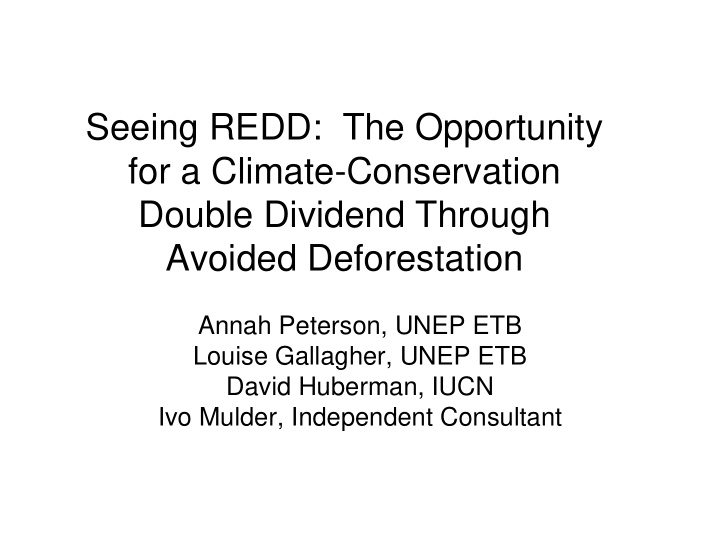



Seeing REDD: The Opportunity for a Climate-Conservation Double Dividend Through Avoided Deforestation Annah Peterson, UNEP ETB Louise Gallagher, UNEP ETB David Huberman, IUCN Ivo Mulder, Independent Consultant
Outline • Background and Research Questions • Example of a REDD project in voluntary markets • Structure of non-profit implemented REDD projects • Structure of for-profit REDD projects • Exploring how for-profit REDD projects can incorporate an additional incentive for biodiversity protections
1.) Can IPES Work for Biodiversity? We specifically consider the option of integrating biodiversity IPES with carbon IPES. 2.) Can REDD provide this link? How can we make sure that forests protected through REDD provide biodiversity conservation in addition to reduced emissions?
While REDD has the potential to deliver a climate - conservation double dividend, this potential may not be realized Monoculture Invasive Diverse Natural Growth Only Reduced Emissions Reduced Emissions and Biodiversity Conservation
Noel Kempff Climate Action Project www.noelkempff.com • Protects 832,000 hectares of tropical forest in Bolivia Investors Contribution Offsets to be Assigned (Million US$) (tCO2e) The Nature Conservancy 2.6 0 Private Investors 8.25 527,427 (AEP, BP, Pacificorp) Government of Bolivia 0 506,743 Total 10.85 1,034,170 • Offsets awarded to the Bolivian Government to be sold on Chicago Climate Exchange • Revenue earned will go to park protection, community development and climate change capacity building
Non-Profit REDD Projects $$ $ Non- Project Investors Profit Area Org VERs RE VERs BC Third Party Verifier RE = Reduced Emissions VER = verified emission reductions Double Dividend BC = Biodiversity Conservation
For-Profit REDD Projects $$ Project CI Area Positive Externality ? BC VERs RE Third Party Verifier RE = Reduced Emissions VER = verified emission reductions BC = Biodiversity Conservation
Growth of the Chicago Climate Exchange
$$ Project CI Area Positive Externality BC VERs RE Third Party Verifier ? BC $ $$ $ Project Area CI VERs RE Third Party Verifier
2 Types of Biodiversity Beneficiaries • General A globally diffuse set of actors who demand general conservation efforts for the option and existence values they provide • Specific Groups that benefit from the conservation of biodiversity within a specific area (non-profits, pharmaceutical companies, ecotourism companies, research institutions, governments, communities)
2 Possible 2 Types of Biodiversity Payment Beneficiaries Mechanisms • General Fund A globally diffuse set of actors who demand general conservation efforts for the option and existence values they provide • Specific Partnership Groups that benefit from the conservation of biodiversity within a specific area (non-profits, pharmaceutical companies, ecotourism companies, research institutions, governments, communities)
Fund = Per hectare subsidy offered to only high biodiversity REDD projects PROS Fund BC • Addresses the public goods nature of $ $$ biodiversity conservation $ CONS CI • Quantifying biodiversity • Defining threshold VERs RE • Deciding subsidy amount • Diverting financing Third Party Verifier
Partnership = matching of carbon investors with biodiversity investors in a virtual marketplace PROS BI BC • No quantifying biodiversity, defining $ $$ thresholds, deciding $ subsidy amounts or coming up with CI financing necessary CONS VERs CS • Limited application – there are only so many specific biodiversity Third Party Verifier demanders
Save the Giant Habitat Jumping Rat Protection $$ $$$ RE $ VERs ClimateFirst Third Party Verifier
In Summary… 1) REDD has the potential to link carbon and biodiversity IPES, if and only if a more targeted approach to REDD is adopted – one that encourages investment in only high biodiversity forests. 2) One way to ensure this is by combining payments for both reduced emissions and biodiversity conservation into one investment in REDD through either a fund or a partnership.
Recommend
More recommend